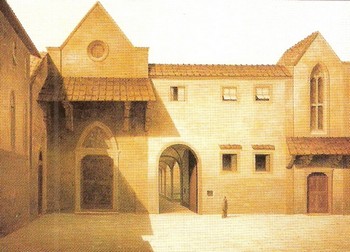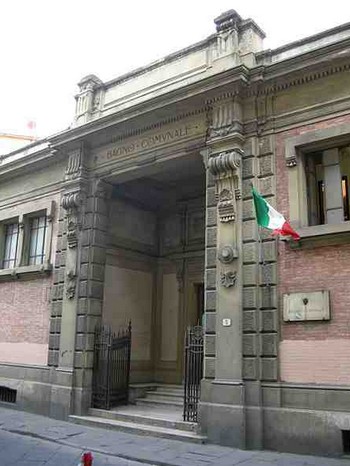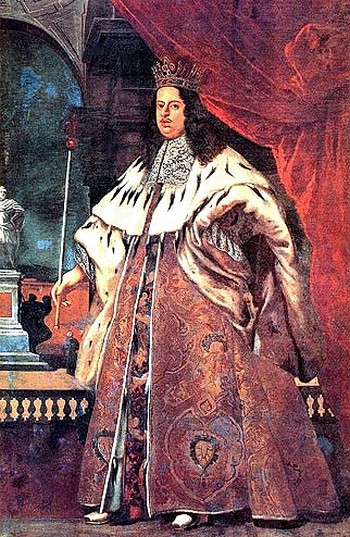Introduction
The title already indicates what is the object of this note. Without even mentioning it, the same title also indicates where the action takes place - obviously in Florence, if one pays some attention to the special cards mentioned. When the events occurred will instead require a better definition below, because the 17th century is not involved as a whole.
Some explanation can also be added about why I am now discussing this topic: a connection may actually be found between this note and a recent study on the exports of Minchiate from Florence, in the following century. (1) From that information it is easy to deduce that a real vogue of Minchiate was flourishing by then in Rome and in most European capital towns; moreover, the destination of several deliveries of Florentine Minchiate could be associated with small territories, kept by noble landlords. It appears in conclusion that that vogue did not particularly correspond to a mass pastime, but was limited to the upper classes.
We would like to better know the actual situation in Florence itself, where the game was born and has been enjoyed for four centuries. Here we examine two local laws from the 17th century: the former belongs to its beginning, the latter to its end. We can thus obtain an idea of the local popularity of the game in the 17th century, before any international spread of the Minchiate vogue.
1. 1606 - In Orto di Santa Maria Nuova
The law under examination is present in a section of the ASF. (2) However, the same text, with only some minor variations in the spelling of a few words, is present in a well-known publication of the Florentine laws. (3)
The Hospital of Santa Maria Nuova is still active as such in the centre of Florence; rather it is indeed the only ancient hospital that has remained active in its original place within the town. Information on its long history is easy to find, because it is associated with significant developments in the history of both medicine and fine arts.
Unknown to me is its Orto, or vegetable garden. At present, any garden in that location should be very small, after the several wings and secondary buildings that have been added in the meantime; we can easily imagine however that in the beginning of the 17th century there was still free space enough around the Hospital.
Whichever the real dimension and shape of that garden, we learn from the law under examination that playing several games was allowed there. Not only, there was also an Ortolano: the name should verbatim corresponds to a gardener, but his function was clearly that of manager of the playing area.
We have thus several positive elements for understanding that some games could be allowed there: the place was open to the public, game sets were available, and there was a responsible manager, who was charged of the control. This was likely the best place if not the only one in which playing some games was completely allowed in Florence.
Now, we are ready to gain knowledge of the games that people could play there at the time. We cannot expect dice or other gambling games, and indeed they are not even mentioned. Only three games were allowed there.
A game that one could easily expect to find, in the open air, is the game of Pallottole. That name is now mostly used with the meaning of bullets, but here the meaning is that of small balls: the game was thus Bocce, one of the several bowl games with a long history.
I am actually much more interested in the two remaining games, both played with cards. It may appear as an extraordinary situation to find two thirds of the games based on playing cards, without even a board game mentioned. Fact is however that these were not common cards, clearly not the cards with which Primiera or similar games were played; and only two packs were available for each game.
The first kind of special cards allowed is fully expected, Germini. It would have been strange if this traditional game were not present among the allowed ones. Somewhat unexpected, to me at least, is the second game allowed by then in Florence, Tarocchi. This is one of the very infrequent cases, or may be the unique one, in which I am finding Tarocchi recorded as used in Florence.
Most important for us is that we find two such packs and games mentioned. This can be considered as the starting point for a subsequent discussion on the members of this family of games: on the basis of the information here provided, it is certain that they were two at least.
2. 1693 -At barbershops and hot baths
If we have previously met Germini and Tarocchi, in 1693 we find Minchiate as the object of a new law. (4) Almost a full century has passed since the previous law. It is hardly possible to find either Germini or Tarocchi still mentioned in Florence. Minchiate is by now the common name of the traditional Florentine game. It only remains to understand how much popular this game was at the time, and which was the typical milieu for its practice.
The law of 3 January 1693 provides useful information. The spread of Minchiate had reached such a popularity that lawmakers had to take more rigorous measures against it. The new law forbids the game to be played in any place - this however only in the evening and by night, after the bell’s sound. In particular, the meaning of Campana dell’arme, was that ringing this bell corresponded to the evening moment at which all weapons had to be dropped down.
As for the places involved, first of all barbers and their shops are mentioned, then Stufaioli, operators of hot baths, both cases not properly corresponding to elitist environments; then more pretentious milieus are indicated too, academies included.
Obviously, a new law with these prohibitions was not necessary, if the game was only played by the high classes. If now Minchiate cannot be played any longer late in the evenings at barber shops and hot baths, this implicitly means that they had become typical places, and typical times, for playing the game: anybody could play Minchiate at a barber shop or a hot bath, and anybody could do it, even after this new law – one had just to stop playing at the beginning of the night.
Thus the card games requiring a new law for limiting the authorisation to play them are now reduced to just one, the one and only one card game that had remained as the most popular in Florence.
3. A comment
The 1606 date for using Tarocchi in Florence is both early and late. Early, because the spread of that game – or, at least, of that name for the game – was rather recent; late, because in the lists of local playing cards I could not find Tarocchi produced in Florence later on. Alongside of ordinary Piccole and Grandi cards, I could only find Minchiate listed.
Of course, I am familiar with the suggestions that Tarocchi were used in Florence before the local introduction of the new Germini-or-Minchiate special Florentine game, but historical evidence for that is little known, if not unknown at all.
Let us be satisfied with the evidence that playing Germini and Tarocchi was by then a pastime for common people, only in competition as a playing offer with a similarly popular Bocce game. Any Floentine citizen could play these games till sunset, provided he was older than 25 years.
Then, in 1693, we find Minchiate, and the problem arises whether we are in the presence of a total of two or three members of the same family. The easiest conclusion is that Germini and Minchiate were two different names for the same Florentine pack and game, whereas Tarocchi was the current name for the 78-card pack that was used in several Northern regions of Italy and which left very few traces in Florence. However, we are not 100% certain, in particular, that Germini and Minchiate were exactly the same game.
4. A flashback
In considering the members of this family of games, we cannot avoid an excursion into the previous centuries, when again we find some names for members of the family. We may hope to start from the roots themselves of the whole family and reconstruct its members in order.
In the 15th century, we first find only Trionfi mentioned, then Minchiate appears. To be scrupulous, it is not even clear whether this Minchiate name corresponded to the same pack and game, which we know from the following centuries. It is possible, in other words, that we have as a whole no fewer than five members of the family, Trionfi of course, the pioneer game, Minchiate I, Tarocchi, Germini, and Minchiate II.
The special game that was initially known as Trionfi gave birth to several children, or was then accompanied by several brothers, if one prefers. How many were the members of the family is not clear yet, to me at least. In this general uncertainness, we have a fixed point from the law of 1606 discussed above: two was the smallest possible number!
In a statute of the 16th century the identity is suggested between Germini and Trionfi grandi (which leaves us wondering what could be the specific name for Trionfi piccoli, if any). (5) The situation of these games and corresponding names was not clear even in the previous century. (6)
I personally find that five as the maximum is somewhat higher than necessary, but having taken the whole history into account has left us with a situation more complex than that of the 17th century examined here, instead of simplifying it.
Conclusion
In Florence several laws were promulgated in the 17th century against card games, to begin with Primiera and several of its variants, up to Bassetta more frequent near the end of the century. However, card games played with the local “triumphal” packs were generally allowed and found a remarkable popularity.
At the beginning of the century, we encounter both Germini and Tarocchi as the only allowed games, at least to Florentine citizens older than 25 years. At the end of the century, we find Minchiate played everywhere, and even requiring a new law to become forbidden by night.
If we extend the analysis to previous centuries, down to the first appearance of Trionfi and early Minchiate, the question of how many were the members of this family of games becomes complex to answer, with some possible endorsement for any number from two to five.
APPENDIX – TEXT OF THE ORIGINAL LAWS DISCUSSED
|
A1. Bando / In aumento dell’Ordine del 1605, circa i giuo/chi, che sono permessi nell’Orto di S./Maria Nuova. / Pubblicato il dì venti di Giugno / MDCVI.
Il Serenissimo Grandua di Toscana, e per Sua Altezza Serenissima li Spettabili Signori Otto di Balìa mossi da giuste, e ragionevoli cagioni, che l’esperienza ne ha mostrate, aggiugnendo al Decreto, e Ordine per lor Signorie fatto sino sotto dì ventisei di Aprile 1605. per il quale si proibisce, e comanda, che nell’Orto del Giuoco di S. Maria Nuova non possi giocare altri, che solo Cittadini statuali, né ad altri giuoco, che a Germini, e Tarocchi con due paia di Tarocchi, e Germini per volta, e pallottole, proibendo in tutto, e per tutto il giuocare come si dice a chiamare, alla bassetta, alla scoperta, & all’alzata; aggiungendo all’ordine solito, qual resti nondimeno nel suo vigore, & osservanza, proibiscano, e comandano, che in detto giucoco non vadino, se non quelli, che sono di età da venticinque anni in su, quali non vi si possino trattenere se non sino all’ave maria delle ventiquattro ore, né vi si possa giuocare ad altro, che a Germini, e Tarocchi, come di sopra, & alle pallottole sotto le medesime pene, e pregiudizi, che nel suddetto Decreto si contengono, & all’Ortolano che tiene il giuoco di Stinche, di fune, di Confini, & altre pene a dichiarazione del Magistrato sino alla Galera inclusive.
Donato Rofia Cancelliere demandato ss.
Bandito per me Francesco Guidalotti Banditore questo dì 20. di Giugno 1606.
A2: Adì 3. Gennaio 1692. (=1693)
Gli spettabili Signori Otto di Gardia, e Balia della Città di Firenze d’espresso Comandamento di S.A.S. fanno notificare, e Publicamente intendere a tutti i Barbieri, Stufaioli, & altre persone di qualsivoglia Stato, Grado, e Condizione, che avessero in qualunque modo facultà di tenere nelle loro Botteghe Stanze Arcadie, o Accademie il Gioco delle minchiate, che in avvenire doppo la Publicazione del presente Bando non siano arditi di ritenere tal Gioco, o dar comodità di giocare doppo il suono della Campana dell’Arme, sotto Pena tanto a loro, che a quelli che vi giocassero doppo a detto suono della Cattura & Arbitrio rigoroso, e tutto mandantes &c.
Gio. Silvio Caterini Cancelliere Maggiore
Bandito da me Giuseppe Palmieri Pubblico Banditore ne luoghi soliti questo di 3. Gennaio 1692. (=1693).
In Firenze / Nella Stamperia di S.A.S. alla Condotta Per Antonio Navesi 1692 (=1693) / Con Licenza de Superiori.
|
Footnotes:
(1) Franco Pratesi: 1729-1762: EXPORTS OF FLORENTINE MINCHIATE, (2013)
(2) ASF, Consulta poi Regia Consulta, prima serie, Pezzo: 46. No. 54 (pencilled). (Leggi di Toscana riguardanti Affari di Polizzia. Classe VII. II, 1606.)
(3) Lorenzo Cantini, Legislazione toscana raccolta e illustrata. Firenze, 1804, Tomo. XIV, p. 316-17.
(4) ASF, Consulta poi Regia Consulta, prima serie, Pezzo: 30. Bando No. 49 (pencilled).
(5) Franco Pratesi, The Playing-Card, Vol. 40 No. 3 (2012) p. 179-197
(6) Franco Pratesi: ON TRUMPS, TRIUMPHS, AND TAROTS, (2012)
|

Antica facciata dell' Ospedale
di Santa Maria Nuova
(by Fabio Borbottoni, 1820–1902)

Florence, a Bagno Communale
(later than 17th century)

Cosimo III de' Medici (1642 – 1723)
"Cosimo's 53-year long reign, the longest in Tuscan history, was marked by a series of ultra-reactionary laws which regulated prostitution and banned May celebrations. His reign also witnessed Tuscany's deterioration to previously unknown economic lows."
It's a good question, to which degree the here described law of 1693 for "barbershops and hot baths" belongs to the "ultra-reactionary laws" issued by Cosimo III.
Cosimo III. became reknown for his very difficult marriage with a very difficult French princess. The resulted in children, which also became "very difficult", and both sons were not able to produce heirs. This evolved in the situation, that the 49-years-old cardinal Francesco Maria de' Medici, brother of Cosimo III and alreay detoriated, had to retire from the post as cardinal and to marry a young Gonzaga princess (1709) and to try his best. The attempt ended in his soon death two years later. It became then very clear, that the house of Medici would end soon.
|
|


